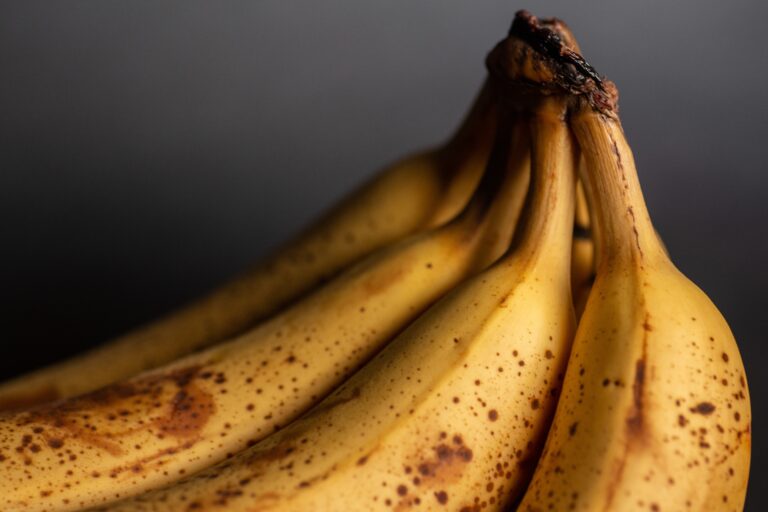Food and Nutrition Education Resources
What To Do With Produce That's Extra Ripe
By: Jaz Popa, 10/19/2022

Overripe produce can have a mushy, less-than-desirable texture, but that doesn’t mean it’s a lost cause! There are many ways to use overripe produce. Instead of tossing it in the trash, save your food dollars, get creative, and try using that extra ripe produce in a new way.
Soups and stews are perfect places to hide produce that’s at the end of its life. Just chop your produce to your desired size and throw it into your favorite warm, comforting stew. Be sure not to put it in too early — the overripe produce is already soft, so it won’t take as long to cook as other vegetables.
It’s easy to let extra ripe produce go from soft to spoiled. Once it’s on the verge of going bad, it happens very quickly. Even if you don’t want to cook the extra-ripe produce right away, it doesn’t mean it has to go in the garbage! Freeze it and save it for later. Click here for a full guide on the best way to freeze different kinds of produce.
Extra ripe, soft veggies blend perfectly into sauces. It will add more veggies to your diet, and you won’t even be able to tell they’re there! Either mash, blend, or finely dice your overripe produce and add it to your sauce as it cooks. It will make a more nutrient-dense sauce and bulk it up to stretch your food dollars.
Overripe produce has the perfect texture to blend easily into a dip. Make it sweet or savory! Roast your produce with your favorite seasonings until it‘s caramelized and extra soft. If you‘re going savory, add in some aromatics like herbs, onions, and garlic, and you will have a very flavorful dip. You can also add some beans or a creamy element to beef up your dip and give it a creamier texture. Eggplant, peppers, beets, spinach, artichokes, and carrots are some great veggies to turn into savory dips. Sweet potatoes, beets, carrots, pumpkins, and other winter squashes make great sweet dips.
Pickled veggies make a great topping or snack and give a second life to old produce. Cucumbers, radishes, onions, beets, string beans, asparagus, cauliflower, peppers, and tomatoes are all delicious pickled. Click here to see how to quick pickle any veggie. Just remember, quick pickling is different than canning. If you are interested in canning, be sure to follow all the proper precautions to ensure that you are preserving your produce safely. If you are quick pickling, remember that your pickles will not be shelf stable and will not last as long as canned pickled.
Soft fruits are perfect for turning into a jam or sweet topping. Add your fruit into a pot and cook them on low heat until they are soft, bubbly, and thick. Mash the fruit into your desired consistency and add a squeeze of lemon. You can keep it to one fruit and flavor or get creative and combine different fruits! As the fruit cooks down, natural sugars will be released, making your jam even sweeter, so be sure to taste it before adding any additional sweeteners. Remember, making jam this way is not preserving it to be shelf stable. Store it in your fridge, and it will last about a week. If you are interested in making preserved, shelf-stable jams, be sure to follow the proper procedures to ensure you are safely preserving your jam. If you are interested in pickling, canning, and preserving food, here to learn more.
Verging on too-soft fruit makes the best breads, cakes, muffins, and pies. They add flavor, sweetness, moistness, and nutrients. Berries, citrus, zucchini, pineapples, carrots, sweet potatoes, pumpkins, bananas, and apples make incredibly flavorful desserts!
Smoothies and popsicles are some of the easiest and most delicious ways to get a lot of fruits and veggies in your diet and are a great way to transform soft produce into something amazing! Freeze your fruits and veggies, yes, veggies, that are too soft to eat raw, and add them to your favorite smoothie recipe. Not only will you easily increase your veggie intake for the day and get more nutrients and variety in your diet, but it will also taste amazing! Sweet fruit masks the taste of milder vegetables, so you’ll have no idea they’re even in there. Many vegetables also have a natural sweetness to them, so they can actually make your smoothie even sweeter! Kale, cucumber, spinach, cauliflower, beets, sweet potato, zucchini, peas, carrots, pumpkin, and other winter squash are great overripe veggies to add to your smoothies.
Some fruit, like bananas, apples, peaches, avocados, tomatoes, and pears, produce and emit Ethylene. Ethylene is a gas that can cause other fruits and veggies to ripen faster. This means that if you store ethylene-emitting produce near ethylene-sensitive produce, you can ripen things faster! Now, this can be a bad thing and cause your other produce to go bad before you‘d like. However, if you have some produce that you need to ripen quickly, try storing it with your extra–ripe ethylene producers. That will get your fruit ripe in no time. Click here to see a complete list of ethylene–producing and sensitive foods.
Do you or a loved one have a little one in the house? If so, then you know how expensive baby food can be. Save some food dollars and make it at home with your extra ripe produce! Click here to learn how to safely make homemade baby food.
Who doesn’t love a pancake covered in beautiful, sweet fruit? Well, if your fruit is too ripe to eat raw, try mashing it up and adding it to your pancake/waffle batter! The fruit will infuse with the batter and will caramelize as they cook, making them even sweeter. Raspberries, blueberries, strawberries, and bananas are some classic choices, but stone fruit like peaches or apples will also be delicious!
Extra–ripe produce is often full of flavor and juice. Use a fork, blender, or even your hands to mash that produce up. Strain out any remaining fruit flesh and enjoy your fresh pressed juice! You can use it right away or freeze it in an ice cube tray. Use the juice (fresh or frozen) to add some extra flavor to your water, in a sauce, smoothie, homemade salad dressing, or however else you would use that produce. You can even use it to make your own sorbet! Pour your juice into a pan and put it in the freezer. Once it’s just about frozen but not frozen solid, mix it up with a fork, and you will have a delicious frozen treat.
